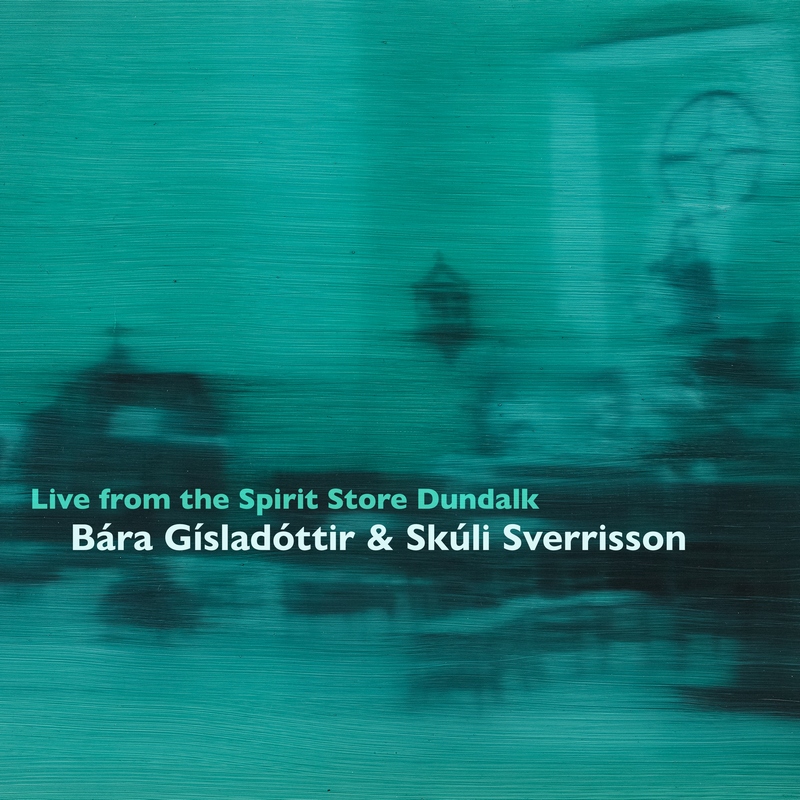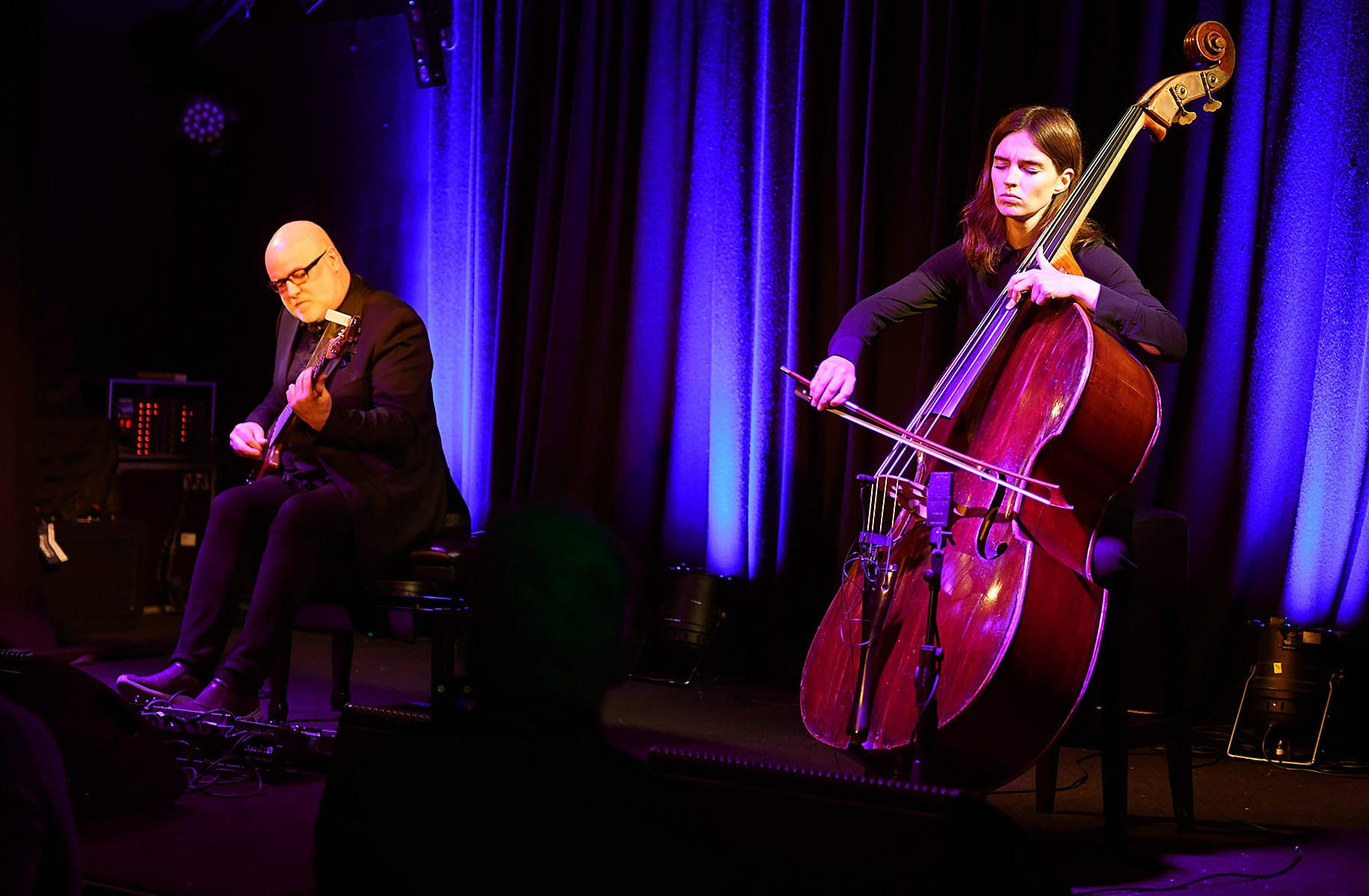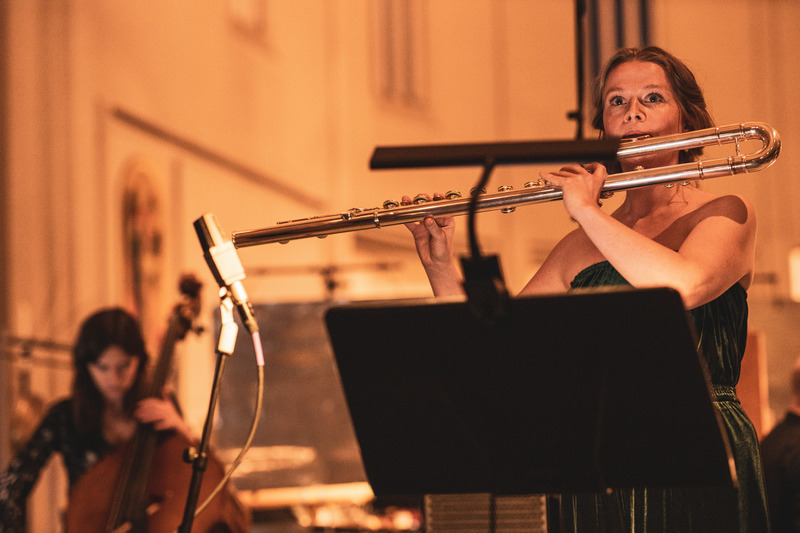Over the last few years i’ve been more and more deeply impressed by the music of Icelandic composer and performer Bára Gísladóttir. First contact was at the Dark Music Days in 2020, when i saw her in action with Skúli Sverrisson, forming a complex double bass / electric bass soundworld that caught me off guard and took some time to process. That experience was nourished by subsequent encounters with Gísladóttir’s solo album HĪBER (one of my best albums of 2020) and, the following year, her double album with Sverrisson Caeli (one of my best albums of 2021) which took what i’d witnessed in Reykjavík and expanded it into a massive 2-hour immersion. Which brings us to 2022, and to the nicely-timed coincidence of two new releases featuring Gísladóttir as both composer and performer.

The first is another of her collaborations with Skúli Sverrisson, recorded earlier this year at the Louth Contemporary Music Festival. The album comprises two sets lasting around 26 and 11 minutes respectively, and the first thing to say is that they’re markedly different in tone from both what i heard at the Dark Music Days as well as the majority of Caeli. There’s a gentleness that pervades these two performances, such that even though they don’t shy away from substantial surges and even dense walls of sound, these are matched by a restraint that indicates a motivation more concerned with articulating than with overwhelming.
It’s not just about restraint, though; throughout both of these sets there’s an emphasis on pitch (and, to an extent, harmony) that, over time, sounds increasingly significant. This is in part due to the way these elements persist through what amount to some pretty intense vicissitudes of noise and sonic dirt. The opening of ‘Set 2’ locates the possibility of pure tones in the midst of a dark cloud, though their purity is soon rendered grainy and fuzzy. It establishes a paradigm of liminal clarity in which a subsequent dronal passage acts to stabilise everything. The centre of ‘Set 2’ is a lengthy oasis, traces of movement and ideas rendered soft-edged, floating in a semi-suspended environment. For the longest time – and despite the presence of further drones – there doesn’t appear to be any effort or possibility to resolve either the pitch tension or the nebulosity of that extended middle sequence; yet somehow, something akin to a ‘tonic’ emerges a couple of minutes before the end. It’s a moment that’s silently catalytic, triggering the music to turn increasingly intimate as it finally dies away.

Throughout ‘Set 2’, the duo are almost impossible to separate, melding together into a single entity, whereas in ‘Set 1’ they’re more divergent. Furthermore, being over twice as long as ‘Set 2’, it’s also much more dramatically extensive. The tension resulting from a similar (un)clarity of pitch has a parallel in the way Gísladóttir and Sverrisson oscillate the structure between passages where melodic or harmonic elements are heard in the midst of varying amounts of obfuscation, and passages of more dronal focus, which act almost like breathers, relaxing things before pushing forward into another period of tension. i spoke of harmony, though there’s something almost illusory about the way this aspect manifests in ‘Set 1’. Sverrisson’s slow-moving basslines often give the impression of actual or implied chord progressions, which sometimes (but not always) are confirmed by higher register material. There’s even a sense, as the piece progresses, that it’s part of a complex passacaglia – with a bassline that’s occasionally audible – cycling around the same harmonic space.
The divergence is most apparent around halfway through, when the music almost becomes akin to a strange two-part invention, though it’s important to stress that there’s always an apparent sympathy between the players. We might call it ‘individuated agreement’, not exactly following each other the whole time yet not going their own way either. Repeatedly they return to plateaux where everything is stable and united, respites from the heightened sequences in between when Gísladóttir’s double bass obsesses over squally, argent filigree while Sverrisson’s bass shapes large growling swells that threaten to consume everything. Some of the most mesmerising passages fall between these poles of pressure and release when the duo are at their most vague, at one point reducing to something like indistinct distorted bells which materialise and vanish as if by magic.

The other new release is also a live performance, of Gísladóttir’s large-scale work VÍDDIR recorded at this year’s Dark Music Days festival in March. (As a personal aside, i’m especially pleased that this has been released as, while i attended most of this year’s festival, due to a several-day hiatus before the closing concerts i wasn’t able to stay for this performance.) VÍDDIR is a grand, hour-long exploration of Gísladóttir’s musical thinking. Again featuring herself and Skúli Sverrisson at its core, together with nine flautists and three percussionists (who also play chamber organ), the work is intended to be performed in spaces with “unique acoustics” (though not explicitly stated, the implication is that they should be large and reverberant). The importance of this is stressed by Gísladóttir’s description of the space being “the fifteenth performer of the piece”. Originally conceived for and premièred in the wondrous interior of Copenhagen’s Grundtvigs Kirke, in this recording it was performed in Reykjavík’s similarly majestic Hallgrímskirkja.
The title of the piece translates as ‘dimensions’, and one interpretation of this is to regard the three groups – flutes, basses, percussion – as occupying separate timbral / behavioural dimensions. (The flutes reinforce the fourth dimension, the performance space, by being physically placed to surround the audience). Throughout the work’s duration these different dimensions are combined in different ways, though it’s only toward the end that VÍDDIR becomes truly three- (or four-) dimensional. In some respects its character bears similarities to the Live from the Spirit Store performances, in the sense that there is also here a tilting between forms of vagueness and clarity, pressure and release, pitch and noise, though the tilting isn’t a simple oscillation but follows an altogether less predictable, more intuitive narrative. Moreover, VÍDDIR embraces extremes, operating on a continuum extending to both unrestrained wildness and almost inaudible calm.

Both of these extremes are heard in the first few minutes, the flutes moving from drones through notes coloured by both singing and screaming to whistle tones and, in conjunction with the percussion (playing unfocused, partially-stopped organ notes), a gorgeously rich place of harmonic stasis. On the two occasions when VÍDDIR switches attention to the basses, they’re entirely unnotated, Gísladóttir and Sverrisson improvising for periods of 7 and 13 minutes. The first of these clarifies the fact that the piece has veered registrally from high to low – another polar extreme – but it also enters into a much more nebulous soundworld, the duo (in a strikingly similar way to Live from the Spirit Store) gently flexing around a point where growls and abrasion sit in close proximity to purity and rest. The second of these sequences expands beyond low registers to move seamlessly between periods of drone and more half illusions of possible harmonic continuity, allowing the music to expand hugely but only briefly. It’s one of a number of passages in the piece that beg the question as to whether this is a strong or a fragile music. The easy answer would be to say it’s both, though i wonder whether it’s actually neither, instead exhibiting an entirely different kind of existence that sidesteps or renders moot such simplistic classifications.
The lengthy middle section, focusing on the percussion, brings to mind Takemitsu’s percussion-centred From Me Flows What You Call Time, specifically the similarly drifting repose passages that fall in between its series of climaxes. Here, it ultimately acts as a relaxed counterweight to the clatter with which the section began, almost like listening to tiny motes of vestigial sound in the aftermath of an explosion. This culminates in another of VÍDDIR‘s extreme moments, an ever-growing multiple tam-tam tremolando that engulfs absolutely everything.

Unexpectedly, the path to multi-dimensional unity begins with a solo instrument: the first bass flute (played by Björg Brjánsdóttir) explores a cadenza – much of which sounds nothing like a bass flute – that pushes both the instrument and the performer to a point that, if taken literally, would surely destroy them. Perhaps acting as a focal point for the shifting, at times desperate, tensions that preceded it, the cadenza provokes a cathartic response, as the remaining flutes, the percussion and, eventually, the basses combine together in a gorgeous half floating music that demonstrates how all three elements, despite appearances, and without sacrificing their basic dimensional characteristics, can become complementary. It’s more complex than that, and a savage metallic crash makes one wonder whether it’s a force of opposition or merely a final fling of sympathetic exuberance; the latter seems more likely judging by the delicate whistles and beautiful triadic hints that colour the work’s closing moments.
Works of this kind can tend to take on a ritualistic quality, suggesting prescriptive actions to achieve predetermined (though perhaps unspecified) ends. Yet VÍDDIR never goes anywhere as certain as that, instead opting to move through its otherwise well-defined dimensions according to an altogether less clear but more intuitively expressive trajectory. In the same way that it defies simple classifications of ‘strong’ or ‘fragile’, its emotional language is similarly elusive: screams feed into sounds that could be read as rapturous; softness occurs in the midst of disquiet. The only thing certain about any of it is its inherent uncertainty – and the fact that it’s hands down one of the most unique, special, haunting and above all stunning pieces of music i’ve heard all year.
Released late last month, Live from the Spirit Store is a digital-only release available from the Louth Contemporary Music Society’s Bandcamp site. VÍDDIR, also digital-only, is released today by DaCapo Records.
